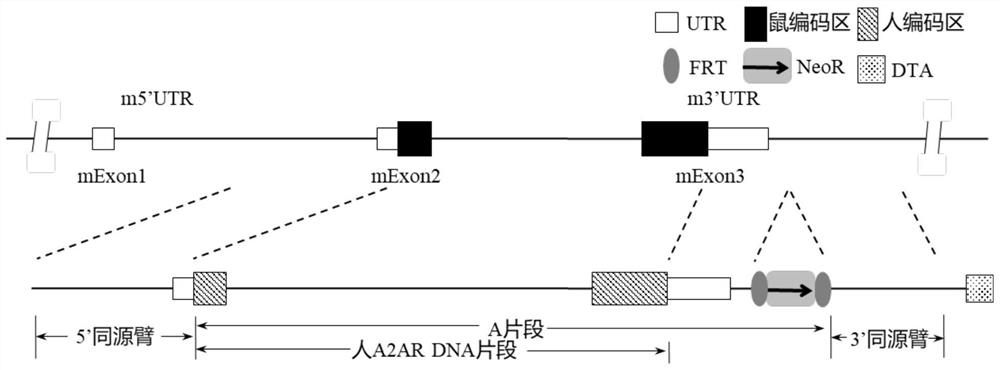A2AR gene humanized non-human animal and construction method and application thereof
A non-human animal, construction method technology, applied in chemical instruments and methods, botanical equipment and methods, biochemical equipment and methods, etc., can solve problems such as genetic complexity
- Summary
- Abstract
- Description
- Claims
- Application Information
AI Technical Summary
Problems solved by technology
Method used
Image
Examples
Embodiment 1
[0197] Example 1 Preparation of A2AR Gene Humanized Mice
[0198]Mouse A2AR gene (NCBI Gene ID: 11540, Primary source: MGI: 99402, UniProt ID: Q60613, located at positions 75316877 to 75334792 of chromosome 10 NC_000076.6, based on transcript NM_009630.3 and its encoded protein NP_033760.2 (SEQ ID NO: 1)) and human A2AR gene (NCBI Gene ID: 135, Primary source: HGNC: 263, UniProt ID: P29274, located at positions 24423597 to 24442360 of chromosome 22 NC_000022.11, based on transcript The comparison diagram of NM_001278497.1 and its encoded protein NP_001265426.1 (SEQ ID NO: 2)) is as follows figure 1 shown.
[0199] In order to achieve the purpose of the present invention, the gene sequence encoding human A2AR protein can be introduced into the mouse endogenous A2AR locus, so that the mouse expresses human or humanized A2AR protein. Specifically, the corresponding sequence of the mouse can be replaced by the nucleotide sequence (such as DNA sequence, cDNA sequence, etc.) The ...
Embodiment 2
[0225] Example 2 In vivo efficacy verification
[0226] A2AR humanized mice prepared by this method can be used to evaluate the efficacy of modulators targeting human A2AR. For example, A2AR humanized mouse homozygotes were subcutaneously inoculated with mouse colon cancer cells MC38, and the tumor volume grew to about 100 mm. 3 Afterwards, they were divided into control group or treatment group according to tumor volume. The treatment group randomly selected compounds X, Y, Z, etc. targeting human A2AR, and the control group was injected with an equal volume of normal saline. Regular measurement of tumor volume and weighing of mice can effectively assess the in vivo safety and efficacy of compounds by comparing changes in mouse body weight and tumor size.
Embodiment 3
[0227] Example 3 Dual-gene or multi-gene humanized mice
[0228] Using this method or the prepared A2AR gene humanized mouse, a double-gene modified or multi-gene modified mouse model can also be prepared. For example, in the aforementioned Example 1, embryonic stem cells used for blastocyst microinjection can be selected from mice containing PD-1, PD-L1, CTLA4, OX40, LAG3, TIM3, CD73 and other genetic modifications, or, alternatively, On the basis of humanized A2AR mice, the mouse ES embryonic stem cell isolation and gene recombination targeting technology can be used to obtain A2AR and other gene-modified double-gene or multi-gene-modified mouse models. The A2AR mouse homozygote or heterozygote obtained by this method can also be mated with other gene-modified homozygous or heterozygous mice, and the offspring are screened. Gene-modified double-gene or poly-gene-modified heterozygous mice, and then the heterozygotes can be mated with each other to obtain double-gene or poly...
PUM
 Login to View More
Login to View More Abstract
Description
Claims
Application Information
 Login to View More
Login to View More - R&D Engineer
- R&D Manager
- IP Professional
- Industry Leading Data Capabilities
- Powerful AI technology
- Patent DNA Extraction
Browse by: Latest US Patents, China's latest patents, Technical Efficacy Thesaurus, Application Domain, Technology Topic, Popular Technical Reports.
© 2024 PatSnap. All rights reserved.Legal|Privacy policy|Modern Slavery Act Transparency Statement|Sitemap|About US| Contact US: help@patsnap.com










